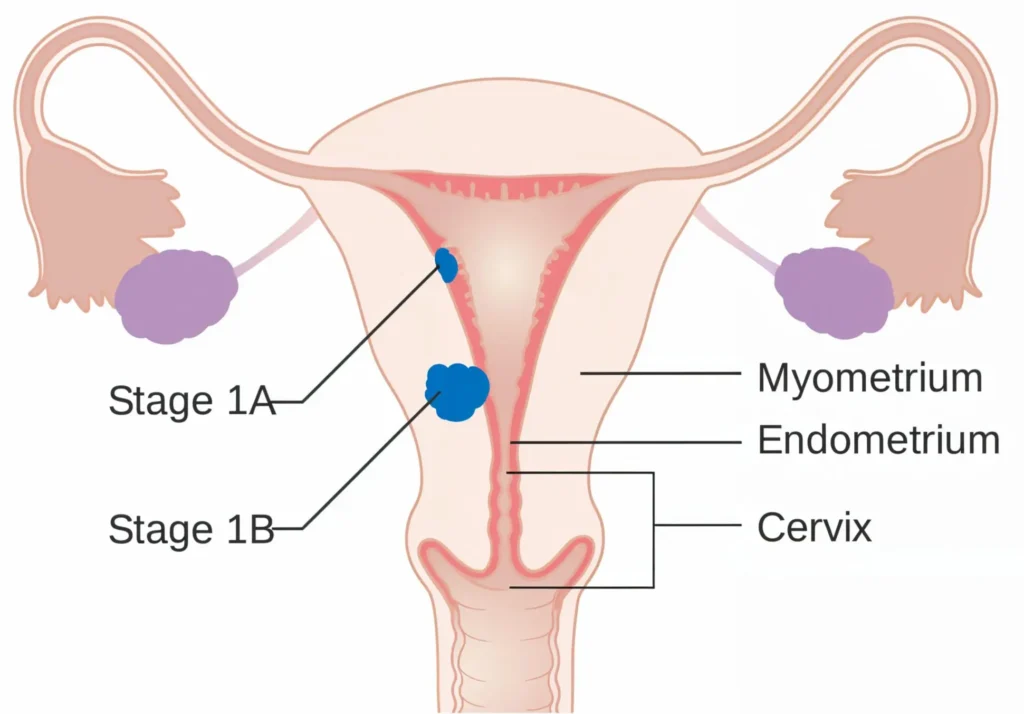Uterine cancer is a type of cancer that begins in the lining of the uterus, and it’s important for women to understand the stages of uterine cancer to determine how far the cancer has spread. Early detection is key in treating uterine cancer effectively. At Deepa Hospital, we provide comprehensive care, including a detailed assessment of the uterine cancer stages, to ensure that every patient receives the most appropriate treatment based on their specific condition.
Finding Out Your Stage
What stage is uterine cancer usually found? Determining the stage of uterine cancer is crucial for treatment planning. The stages of uterine cancer are determined by how much the cancer has spread, which helps doctors figure out the most effective treatment. What is Stage 4 uterine cancer? During the diagnostic process, tests like imaging scans, biopsies, and surgical procedures will reveal the stage. The earlier uterine cancer is diagnosed, the more options there are for treatment, and the better the chances for successful outcomes.
Stage I
- Symptoms:
- In Stage I, uterine cancer is confined to the uterus. Symptoms may include abnormal bleeding or pelvic pain, though some cases show no symptoms. The stages of uterine cancer help in guiding treatment and improve prognosis when detected early..
- It is important to keep track of any changes in your menstrual cycle or unusual bleeding patterns.
- Treatment:
- Stage I uterine cancer is typically treated with a total hysterectomy (removal of the uterus and cervix), and sometimes, the removal of nearby lymph nodes.
- Depending on the situation, radiation therapy may also be suggested to reduce the risk of cancer spreading.
Stage II
- Symptoms:
- In Stage II, the cancer has spread beyond the uterus to the cervix but hasn’t reached other organs. Symptoms can include pelvic pain, abnormal bleeding, and discharge.
- As with Stage I, symptoms may be mild and unrecognized. Knowing the uterine cancer stages helps with early detection and treatment.
- Treatment:
- Stage II uterine cancer is typically treated with surgery, which involves removing the uterus, cervix, and possibly surrounding tissues. Chemotherapy may be recommended, especially if there’s a risk that the cancer could spread further.
Stage III
Stage III is when cancer spreads beyond the uterus to nearby organs or tissues. The stages of uterine cancer help determine the extent of spread and guide treatment.
Stage IIIA
- Symptoms:
- Cancer has spread to the outer layer of the uterus. Symptoms may include pelvic pain, abnormal bleeding, and difficulty urinating or passing stool.
- Treatment:
- Treatment involves surgery to remove the uterus and possibly lymph nodes, with chemotherapy targeting spread cancer cells, based on the uterine cancer stages.
Stage IIIB
- Symptoms:
- In Stage IIIB, cancer has spread to the vagina or surrounding tissues. Symptoms include vaginal bleeding, pelvic pain, or discomfort during urination.
- Treatment:
- Treatment typically involves surgery to remove the uterus and possibly nearby lymph nodes, followed by radiation therapy and chemotherapy to address any remaining cancer.
Stage IIIC1
- Symptoms:
- Cancer has spread to pelvic lymph nodes. Symptoms may include pain or swelling in the pelvic area and abnormal bleeding.
- Treatment:
- Surgery to remove the uterus and lymph nodes is common. After surgery, chemotherapy is often used to target any remaining cancer cells in the pelvic area.
Stage IIIC2
- Symptoms:
- Cancer has spread to abdominal lymph nodes. Symptoms include bloating, pelvic pressure, and possible weight loss or fatigue.
- Treatment:
- Stage IIIC2 is often treated with a combination of surgery, chemotherapy, and radiation. This approach targets the spread of cancer and helps reduce the risk of further growth.
Stage IV
Stage IV is the most advanced stage, where cancer spreads to distant organs like the bladder or rectum. The stages of uterine cancer help guide treatment based on the spread.
- Symptoms:
- Common symptoms of Stage IV uterine cancer include pain in the pelvic area, weight loss, fatigue, difficulty urinating, and digestive issues.
- The cancer may have spread to nearby organs, and you may experience significant changes in your body.
- Treatment:
- In Stage IV, treatment includes surgery, chemotherapy, radiation, and palliative care. How do you beat Stage 4 uterine cancer? The goal is to manage symptoms and improve quality of life
- The goal is to manage symptoms and control the spread of cancer, as curing Stage IV uterine cancer is more difficult.
Impact of Uterine Cancer on Fertility
- Stage I and II:
- Fertility-sparing options may be available for early-stage cancers, depending on the patient’s health and desires.
- Treatments may include hormonal therapy or surgery to remove only the affected part of the uterus.
- Stage III and IV:
- Fertility-sparing options are less likely due to the spread of cancer.
- Focus shifts towards treatment and preserving overall health.
- Post-treatment Fertility:
- Chemotherapy and radiation can affect fertility.
- Options like egg freezing or surrogacy can be considered before starting treatment.

What Is Uterine Cancer Stage 4?
Stage 4 uterine cancer refers to the most advanced stage, where the cancer has spread to distant organs. At this stage, the disease may have spread to the bladder, rectum, or even areas outside of the pelvic region. What is Stage 4 uterine cancer? Treatment for Stage 4 uterine cancer may involve chemotherapy, surgery, and radiation therapy. The prognosis at this stage can be challenging, but the goal of treatment is to manage symptoms and improve the quality of life.
How Do You Fight Stage 4 Uterine Cancer?
Knowing what stage is uterine cancer usually found you can answer How do you beat Stage 4 uterine cancer? Treatment for Stages of uterine cancer is more aggressive and includes chemotherapy, radiation therapy, and potentially surgery. Targeted therapy or immunotherapy may also be considered, depending on the specific characteristics of the cancer. A multi-disciplinary approach is critical, and your doctor will tailor a treatment plan based on your individual situation.
How Is Endometrial Cancer Stage Determined?
Identifying the endometrial cancer stage is essential for creating an effective treatment plan and understanding prognosis.
- Pelvic Exam, Imaging & Biopsy
Initial staging involves a pelvic examination, imaging tests like MRI or CT scan, and an endometrial biopsy to confirm the presence and grade of cancer. These steps help assess tumor size and spread to nearby tissues. - Surgical Staging with Lymph Node Analysis
A hysterectomy is often performed to examine how far the cancer has spread. During surgery, lymph nodes are also removed and tested, which helps determine whether the cancer is localized or has metastasized. - FIGO Staging System
The FIGO system combines clinical and surgical findings to classify cancer from Stage I to IV, guiding doctors in selecting the most appropriate treatment based on disease progression.
Conclusion
Understanding the stages of uterine cancer is crucial for effective treatment and better outcomes. From Stage I, where cancer is confined to the uterus, to Stage IV, where the cancer has spread to distant organs, treatment varies depending on the stage. Early detection and proper treatment play a key role in improving survival rates. If you or a loved one is diagnosed with uterine cancer, Deepa Hospital is here to provide you with comprehensive care, expert advice, and support at every stage of the journey.

